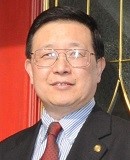主题演讲人

Ali Emrouznejad
Professor and Chair
Business Analytics Aston University
Title: Coming soon
Abstract:Coming soon

Dmitry A. Zaitsev
Professor
Department of Information Technology, Odessa State Environmental University, Ukraine
Title: Sleptsov Net Computing
Abstract:Petri nets have been known for years as a model of concurrent systems but their computationally universal extensions are exponentially slow comparing Turing machines, especially when implementing arithmetic operations. A Sleptsov net concept, suggested quarter a century ago, recently acquired its second birth due to its ability of fast implementation of basic arithmetic operations. Firing a transition in a few instances at a step leads to universal constructs which run in polynomial time. In Sleptsov net computing, a program, written in Sleptsov net language, preserving concurrency of an application area, runs on Sleptsov net processor which implements concurrent firing of transitions in multiple instances providing fast computations. Motivation for new models of hyper-computations is presented. Sleptsov net is introduced compared to Petri and Salwicki nets. A concept of universal Sleptsov net, as a prototype of a processor in Sleptsov net computing, is discussed. A small universal Sleptsov net that runs in polynomial time is constructed; it consists of 13 places and 26 transitions. Principles of programming in Sleptsov nets, as composition of reverse control flow and data, are developed. Standard control flow patterns include sequence, branching, loop, and parallel execution. Basic modules, which implement efficiently copying, logic, and arithmetic operations, are developed. Special dashed arcs are introduced for brief specification of input and output data of modules (subnets). Ways of hierarchical composition of a program via substitution of a transition by a module are discussed. Examples of Sleptsov net programs for data encryption, fuzzy logic, and partial differential equations are presented. Enterprise implementation of Sleptsov net computing promises ultra-performance.

Schahram Dustdar
Professor
Head the Distributed Systems Group at the Vienna University of Technology, Austria
Title: Edge Intelligence - Edge Computing and Artificial Intelligence
Abstract:With the advent of Edge Computing and the coming of age of Artificial Intelligence, there is a strong demand to integrate Edge Computing and AI, which gives birth to Edge Intelligence. In this talk, wedivide Edge Intelligence into AI for Edge (Intelligence-enabled Edge Computing) and AI on Edge (Artificial Intelligence on Edge). We will discuss insights into this new interdisciplinary field from a broader vision and perspective. We discuss the core concepts and the research roadmap, which should provide the necessary background for potential future research programs in Edge Intelligence.

Yingxu Wang
Professor
Department of Electrical and Computer Engineering, Schulich School of Engineering (SSE) and Hotchkiss Brain Institute (HBI), University of Calgary, Canada
Title: Cognitive Computing and Cognitive Robots
Abstract:This keynote presents the latest development in Cognitive Computing (CC) and Cognitive Robots (CR). Basic researches underpinning CC and CR are Intelligence Science (IS) and Intelligent Mathematics (IM). The former, IS, is a discipline that studies Abstract Intelligence (aI) and General AI (GAI) across reflexive, imperative, adaptive, autonomous, and cognitive intelligence from the bottom up. The latter, IM, is a category of contemporary denotational mathematics that extends classic analytic mathematics defined in the domain of real numbers (R) to a collection of novel mathematical structures and cognitive entities known as hyperstructures (H) beyond R. IM enables formal expressions and rigorous manipulations of machine knowledge and intelligence in IS. Investigations into both CC and CR will lead to the next generation of cognitive computers for implementing GAI by deep knowledge learning, causal inferencing, and autonomous decision-making mimicking the brain.

Lv Zhihan
Associate Professor
School of Data Science and Software Engineering, Qingdao University, China
Title: Virtual Reality Content Platform
Abstract:Virtual reality is the technology that can make people immerse into a virtual environment as in a real world. The virtual environment replicates a real or imagined environment, and simulates a user’s physical presence and interactive environment. The immersive environment can be similar to the real world, in order to create a lifelike experience, or it can significantly differ from reality world, such as in virtual reality magic games. The most outstanding feature of virtual reality is immersive. Cutting off the connection between your perception with the virtual world can pull you out of the threat from the virtual environment. It can be described like this; virtual reality makes player’s perception immerse in the virtual environment meanwhile the body is physically in the real world. In reality, human has five senses. The five senses can make human percept different attributes of the world, and bridge the connection between human with the environment. Virtual realities artificially create sensory experience, that can include sight, touch, hearing, and smell. During the senses, the sight is the most important. Some advanced haptic systems now include tactile information. The tactile information is generally known as force feedback. Moreover, virtual reality covers remote communication environments which provide virtual presence of users with the concepts of telepresence and telecommunication either through the use of standard input devices such as a keyboard and mouse, or through multimodal devices such as a digital glove or omnidirectional treadmills. My research is mainly on exploring the combination of Virtual Reality and the emerging technologies, such as Blockchain, Internet of Things, Deep Learning. For example, the combination of Virtual Reality and Internet of Things is Digital Twins, the combination of Virtual Reality and Blockchain is Blocknetwork.

Dr. Eduardo Rodriguez
Assistant Professor
School of Mathematical Sciences, College of Science and Technology, Wenzhou-Kean University, Wenzhou, China
Title: Strategic Intelligence, Digitalization and Strategic Risk
Abstract:Strategic Intelligence is a symbiotic work of artificial intelligence, business intelligence and competitive intelligence. Strategic risk is represented by the probability of having variations in the performance results of the organizations that can limit the capacity to maintain sustainable competitive advantages.
This presentation is about the use of Data Analytics and Digital Transformation in organizations to create Strategic Intelligence that mitigate and control strategic risk.
Nowadays, the goals of organizations include the creation of intelligence and sustainable competitive advantages to tackle the challenges of dealing with strategic risks. Organizations are in the search of new knowledge created by data analytics and the capacity to operationalize that new knowledge through digital transformation as a means to meet their markets demand.
The evolution of organizations is moving from the use of statistical learning and machine learning in data analytics to the improvement and use of new technologies in operations and strategy implementation. The core of the presentation is to connect Data Analytics and AI, Risk Management and Digitalization for creating strategic intelligence as the capacity of adaptation that organizations could have to compete and succeed. The digitalization process is a potential opportunity for organizations; however, the results may not be optimal for everyone. Thus, the main emphasis of the presentation is to examine the required transformation of the modeling process that converts data analytics into actions to mitigate strategic risk based on digital transformation. New risks appear once new knowledge emerges and has been used, but at the same time the new knowledge supports the initiatives to deal with risks of new ways of competing, collaborating and protecting the talent and customers of organizations as means to move forward in their businesses.
Keywords: Strategic Intelligence, Artificial Intelligence, Data Analytics, Strategic Risk

Dongdong Su
Professor
State Key Laboratory of High-end Server & Storage Technology, China.
Title: Accelerating CNN Applications with FPGA Cluster at Edge Computing
Abstract: FPGA-based acceleration has been emerged to avoid the cloud computing overload problem by accelerating the compute-intensive workload on edge networks. Though existing studies for FPGA-based edge acceleration have focused on optimizing the computing time, they did not address the burden of the FPGA-aided server under an enormous computing requests circumstance. The massive computing requests can cause delays in transmission and processing at the FPGA-aided server, leading to long response times and high system energy consumption. Therefore, we propose an emerging edge acceleration architecture based on FPGA cluster over the low-latency RDMA-based network. Preliminary simulation results demonstrate that our architecture is fast, scalable, and energy-efficient in comparison with the FPGA-aided servers cluster.